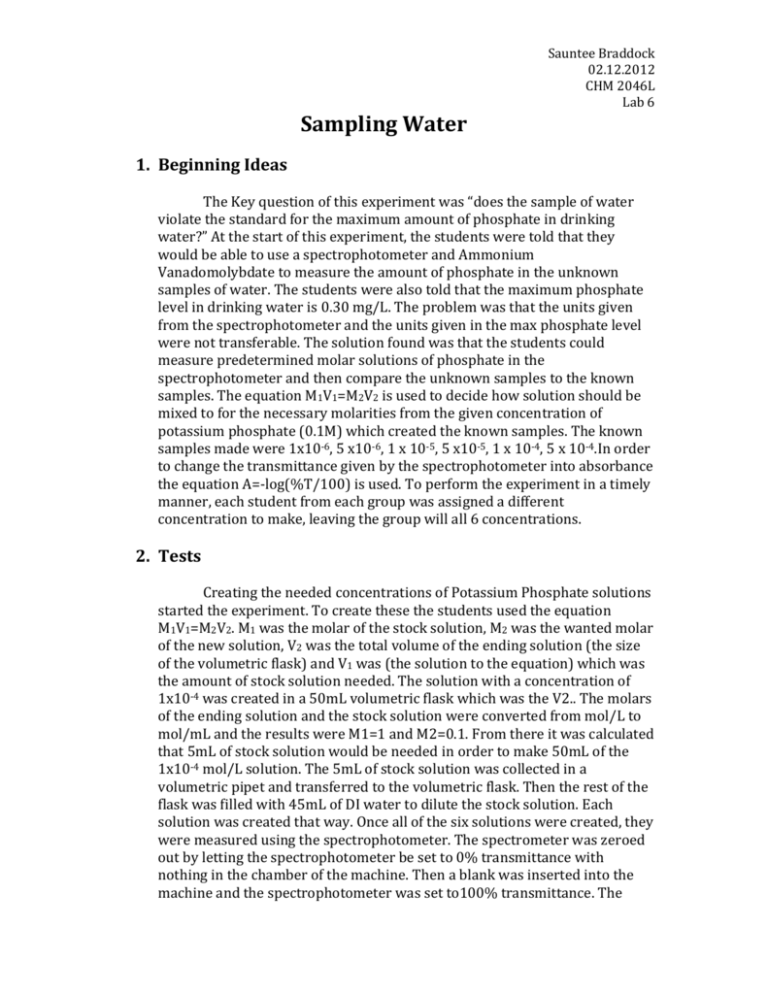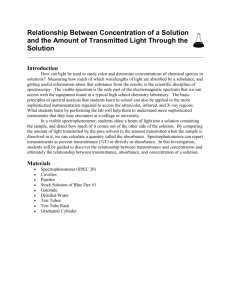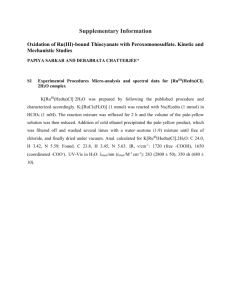
Sauntee Braddock
02.12.2012
CHM 2046L
Lab 6
Sampling Water
1. Beginning Ideas
The Key question of this experiment was “does the sample of water
violate the standard for the maximum amount of phosphate in drinking
water?” At the start of this experiment, the students were told that they
would be able to use a spectrophotometer and Ammonium
Vanadomolybdate to measure the amount of phosphate in the unknown
samples of water. The students were also told that the maximum phosphate
level in drinking water is 0.30 mg/L. The problem was that the units given
from the spectrophotometer and the units given in the max phosphate level
were not transferable. The solution found was that the students could
measure predetermined molar solutions of phosphate in the
spectrophotometer and then compare the unknown samples to the known
samples. The equation M1V1=M2V2 is used to decide how solution should be
mixed to for the necessary molarities from the given concentration of
potassium phosphate (0.1M) which created the known samples. The known
samples made were 1x10-6, 5 x10-6, 1 x 10-5, 5 x10-5, 1 x 10-4, 5 x 10-4.In order
to change the transmittance given by the spectrophotometer into absorbance
the equation A=-log(%T/100) is used. To perform the experiment in a timely
manner, each student from each group was assigned a different
concentration to make, leaving the group will all 6 concentrations.
2. Tests
Creating the needed concentrations of Potassium Phosphate solutions
started the experiment. To create these the students used the equation
M1V1=M2V2. M1 was the molar of the stock solution, M2 was the wanted molar
of the new solution, V2 was the total volume of the ending solution (the size
of the volumetric flask) and V1 was (the solution to the equation) which was
the amount of stock solution needed. The solution with a concentration of
1x10-4 was created in a 50mL volumetric flask which was the V2.. The molars
of the ending solution and the stock solution were converted from mol/L to
mol/mL and the results were M1=1 and M2=0.1. From there it was calculated
that 5mL of stock solution would be needed in order to make 50mL of the
1x10-4 mol/L solution. The 5mL of stock solution was collected in a
volumetric pipet and transferred to the volumetric flask. Then the rest of the
flask was filled with 45mL of DI water to dilute the stock solution. Each
solution was created that way. Once all of the six solutions were created, they
were measured using the spectrophotometer. The spectrometer was zeroed
out by letting the spectrophotometer be set to 0% transmittance with
nothing in the chamber of the machine. Then a blank was inserted into the
machine and the spectrophotometer was set to100% transmittance. The
Sauntee Braddock
02.12.2012
CHM 2046L
Lab 6
blank was created with 10mL if DI water and 5mL of Ammonium
Vanadomolybdate in a cuvette. This is done because the Ammonium
Vanadomolybdate has a faint color to it without anything done to it and must
be factored out of the readings. The students made sure to wipe down the
cuvette before each reading to ensure accuracy. Then, 10mL each sample
concentration of was added to 5mL of Ammonium Vanadomolybdate and
tested in the spectrophotometer. The Transmittance given by each
concentration was recorded, and then converted into absorbance. Next the
two unknown samples were also mixed, 10mL of solution with 5mL of
Ammonium Vanadomolybdate and measured in the spectrophotometer.
These two samples were calculated into absorbance and then placed
accordingly within the absorbances of the known concentrations. The results
were complied in a graph, which demonstrated Beer’s Law.
3. Observations
Table 1 Transmittance of Known Samples
mL of
M of Potassium Phosphate
Concentration
10mL
1 x 10-6
10mL
5 x 10-6
10mL
1 x 10-5
10mL
5 x 10-5
10mL
1 x 10-4
10mL
5 x 10-4
Table 2 Transmittance of Unknown Samples
Unknown Sample mL of Sample
mL AV
#
1
10
5
2
10
5
mL of AV
% Transmittance
5
5
5
5
5
5
100%
98%
95%
87%
74%
34%
% Transmittance
93%
39%
4. Evidence
The transmittance found for each solution was then calculated to
obtain the absorbance of each. The equation used to find absorbance is A=log(%T/100). The absorbances were calculated for both the known and
unknown concentration samples and recorded.
Sauntee Braddock
02.12.2012
CHM 2046L
Lab 6
Table 3 – Calculated Absorbance of Known Samples
Concentration (mol/L)
% Transmittance
-6
1 x 10
100%
5 x 10-6
98%
-5
1 x 10
95%
5 x 10-5
87%
-4
1 x 10
74%
-4
5 x 10
34%
Calculated Absorbance
0
8.77 x 10-3
2.23 x 10-2
6.05 x 10-2
1.31 x 10-1
4.69 x 10-1
Table 4- Calculated Absorbance of Unknown Samples
Unknown Sample #
% Transmittance
Calculated Absorbance
1
93%
3.15 x 10-2
2
39%
4.9x10-1
After the absorbance was calculated for each concentration it was graphed
according to Beer’s law. Beer’s law is the relationship between absorbance and
concentration and is given by A=Ebc. The graph shows this relationship along the
best-fit line between all of the points. From the best-fit line the concentrations of the
unknown samples can be approximated. The unknown sample 1 has an absorbance
of 0.0315 and according to the best-fit line the concentration is approximately
0.00001 mol/L. According to the best-fit equation however the concentration is 2.6
mol/L, which is most likely an error in the computer’s equation. Likewise, the
unknown sample 2 had a concentration of 0.49 and according to the best-fit line the
concentration is approximately 0.0005. This is true because is close to the outlier of
the graph, which was thrown out, but had similar values to the unknown sample.
The equation of the best-fit line gave a concentration of 17.18 mol/L, which is also
likely to be an error.
Table 5- Beer’s Law Graph
Calibration Curve
0.16
0.14
y = 0.0314x - 0.0496
0.12
R² = 0.8568
0.1
0.08
0.06
0.04
0.02
0
-0.02 0.0000010.000005 0.00001 0.00005 0.0001
-0.04
Calibration Curve
Linear (Calibration
Curve)
0.0005
Sauntee Braddock
02.12.2012
CHM 2046L
Lab 6
In addition, to finish the calculations, the given maximum of Phosphate in
water is 0.30 mg/L was converted to mol/L to compare to the samples of water. To
do this the 0.30 was divided by 1000 to put it in g/L and then divided by the molar
mass of KH2PO4, which resulted in 2.2x10-6 mol/L.
5. Claim
Using Beer’s Law, which related concentration and absorbance, the
concentrations of phosphate in the unknown water samples were evaluated. The
maximum amount of phosphate was given to be 2.2x10-6 mol/L while the water
samples were 1x10-5 and 5x10-4 . The samples exceeded the maximum and
therefore violated the allowed amount of phosphate in water.
6. Reading
Testing water samples for impurities is a very important process that
is done on a daily basis everywhere. In the experiment the level of potassium
phosphate in samples of water was the impurity being measured. This is
relevant because phosphate is one water impurity that is extremely common
due to fertilizers, wastewater, treatment plants, soaps etc. (Dixon, pg. 106)
A suitable way of measuring the amount of phosphate in samples of
water is spectrophotometry. In any spectrometer the light of a specific
wavelength, (400nm was used in the experiment), is passed through a
sample and the transmitted light is measured. The measurement changes
based on how much light was absorbed by the sample and this is displayed
by and % transmittance (Nivaldo, 568). In order to measure the amount of
phosphate in a sample using a spectrophotometer however colorimetric
methods must be used. In the experiment, Ammonium Vanadomolybdate,
which is a color-producing agent, was used to color the different
concentrations of phosphate. The higher the concentration of phosphate was
in the solution, the darker the Ammonium Vanadomolybdate turned the
solution and the less transmittance was measured by the spectrophotometer
(Dixon, pg. 108).
For the experiment different concentrations of potassium phosphate
solutions were needed in order to compare the unknown solutions and
determine approximate concentrations of each. These solutions were created
using a stock solution of potassium phosphate and the dilution equation. It
would also have been very practical to use serial dilutions to conserve
resources in the lab. In order to do a serial dilution, the highest concentration
needed for the experiment would be created using the dilution formula and
then every lesser solution after that one would be created from the previous
solution. This conserves the amount of the stock solution and creates all the
needed concentrations as well (Dixon, pg. 108).
Sauntee Braddock
02.12.2012
CHM 2046L
Lab 6
Once all of the concentrations were made and the % transmittance
was measured in a spectrophotometer, the values were converted to
absorbance and the related to concentration using Beer’s law. The formula
used to convert % transmittance into absorbance is A=-log(%T/100) which
can be manipulated in many ways. Beer’s Law is A=Ebc where A is
absorbance and has no units, E is molar absorbity with the unit of mol-1 cm-1,
b is the pathlenght which is in cm (usually set at 1 cm), and c is the
concentration of the solution in mol L-1. This law was shown in the
experiment by creating a graph of absorbance and concentrations and a
trend-line was drawn. From that line the unknown concentrations were
easily distinguishable (Sheffield).
7. Reflection
The beginning ideas of this experiment were proven to be suitable.
Creating concentrations of potassium phosphate and pairing them with a
color producing agent such as Ammonium Vanadomolybdate is a good way
to determining the concentration of unknown samples. It was shown by the
evident of the experiment that the samples of water did in fact violate the
maximum amount of phosphate allowed in drinking water. This was done by
calculating the concentrations of the unknown using the Beer’s Law graph
and then converting the given maximum amount of phosphate into the
correct units. The concentrations were created using the dilution formula,
M1V1=M2V2. The absorbance was calculated from the % transmittance using
the equation A=-log(%T/100).
During this experiment much error was possible. With the
calculations of the concentrations of the unknown solutions, the equation of
the best-fit line should have given the concentration by entering the
absorbance of the sample into the equation for y and then solving for x. This
however was not accurate. This was a systematic error that was most likely
due to a mistake in the computer-formulated equation. This was corrected,
for the most part, by making approximations according to the best-fit line of
the graph instead of using the formula. Due to this error, the concentrations
are not as accurate as they could but are still precise. Other errors that might
have occurred were inconsistency in making exact concentrations because
the same person may not have made all of the concentrations themselves,
which would be a random error; as well as faulty spectrophotometers that
may not have given accurate readings, which would be a systematic error.
8. Writing
In conclusion, this experiment was done to measure impurities in a
water sample, practice in making solutions of different concentrations, using
a spectrophotometer, and using graphing techniques. These are very
Sauntee Braddock
02.12.2012
CHM 2046L
Lab 6
important skills to have as a chemist. Spectrometers may be used to measure
many different things such as concentrations, and reaction rates. Graphing is
an important technique that will always be used to present and compare
results of experiments. Making solutions is important in preparing for any
experiment involving aqueous solutions, which is most.
In terms of real life situations, measuring the purity of water is very
important. With 2/3 of the world covered in water, very little of that is
actually clean enough to drink. Without ways to test for dangerous
substances in water, people would become very sick all over the world just
from drinking water, an element of life itself. Phosphate is just one of the
many toxins that get into water and can make it undrinkable. Therefore,
water tests are extremely important to everyday life!
9. Post Lab Questions
a. Why would we care about the amount of the PO4 3- found in natural
drinking water?
The amount of PO4 3- found in natural drinking water is very important
because phosphate is a dangerous toxin in water that can make it unsafe to drink. A
standard has been set that states the acceptable amount of phosphate in drinking
water before it becomes dangerous. If the amount of phosphate exceeds this
standard then it should not be consumed until it is purified and therefore it is
important to know how much PO4 3- is in the water.
b. If you really wanted to be sure your water was drinkable, what further
purification step(s) would you take?
In order to ensure that water is drinkable a purification step that may be
taken is testing of the pH levels in the water. Water should be neutral at 7 but if it is
more acidic or basic then it may contain unwanted impurities such as bacteria.
c. Blue light has a wavelength between 450-495 nm. Why don’t we
measure the absorbance of a blue solution within this wavelength
range?
It would not be suitable to measure the absorbance of a blue solution within
the wavelength of blue light because blue is the mixture of colors that is being
reflected off of a substance and measuring a blue light on that substance would not
give an accurate reading of light.
Works cited
Tro, Nivaldo J. Chemistry: a Molecular Approach. Upper Saddle River,
NJ: Pearson Prentice Hall, 2011. Print.
Dixon, Donovan. Chemistry 2046L. Eden Prairie, MN: Bluedoor, LLC,
2011. Print
Sauntee Braddock
02.12.2012
CHM 2046L
Lab 6
University, Sheffield. “Beer’s Law-Theoretical Principles.”
Http://teaching.shu.ac.uk. Web. 12 Mar. 2012
<http://teaching.shu.ac.uk./hwb/chemistry/tutorials/molspec/beers1.htm>.









